SSH框架整合
前言:有人说,现在还是流行主流框架,SSM都出来很久了,更不要说SSH。我不以为然。现在许多公司所用的老项目还是ssh,如果改成主流框架,需要成本。再说比如金融IT这一块,数据库dao层还是推荐使用的是hibernate,因为能够快速开发上手,除非是互联网,因涉及到高并发,dao层用的是mybatis,数据交互效率较快。所以,SSH不容忽略。
一、什么是SSH
SSH是 struts+spring+hibernate的一个集成框架,是目前比较流行的一种Web应用程序开源框架。
集成SSH框架的系统从职责上分为四层:表示层、业务逻辑层、数据持久层和域模块层,以帮助开发人员在短期内搭建结构清晰、可复用性好、维护方便的Web应用程序。其中使用Struts作为系统的整体基础架构,负责MVC的分离,在Struts框架的模型部分,控制业务跳转,利用Hibernate框架对持久层提供支持,Spring做管理,管理struts和hibernate。具体做法是:用面向对象的分析方法根据需求提出一些模型,将这些模型实现为基本的Java对象,然后编写基本的DAO(Data Access Objects)接口,并给出Hibernate的DAO实现,采用Hibernate架构实现的DAO类来实现Java类与数据库之间的转换和访问,最后由Spring做管理,管理struts和hibernate。
---------百度百科
二、SSH所涉及的部分
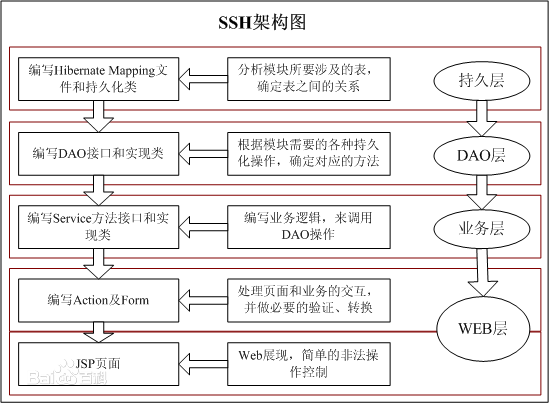
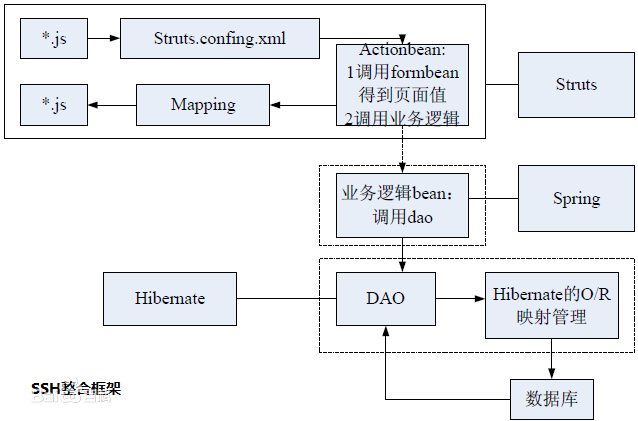
三、快速部署环境
这里利用保存客户的小Demo来演示整合SSH
1.导入所需jar包
1). Struts2框架
* struts-2.3.24appsstruts2-blankWEB-INFlib*.jar -- Struts2需要的所有jar包
* struts2-spring-plugin-2.3.24.jar ---Struts2整合Spring的插件包
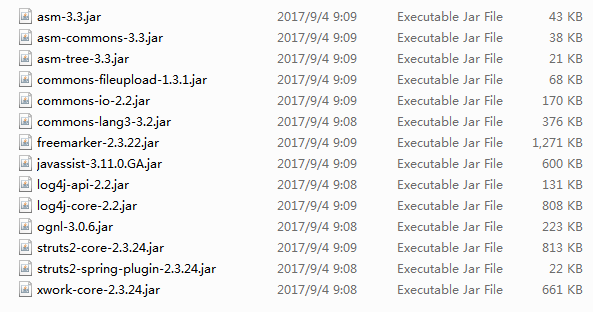
2). Hibernate框架
* hibernate-release-5.0.7.Finallib equired*.jar -- Hibernate框架需要的jar包
* slf4j-api-1.6.1.jar -- 日志接口
* slf4j-log4j12-1.7.2.jar -- 日志实现
* mysql-connector-java-5.1.7-bin.jar -- MySQL的驱动包

3). Spring框架
* IOC核心包
* AOP核心包
* JDBC模板和事务核心包
* Spring整合JUnit测试包
* Spring整合Hibernate核心包
* Spring整合Struts2核心包

2、在web.xml中配置spring与struts的相关代码
1)配置struts2核心过滤器
这里定义为拦截所有
<!-- 配置核心过滤器 -->
<filter>
<filter-name>struts2</filter-name>
<filter-class>org.apache.struts2.dispatcher.ng.filter.StrutsPrepareAndExecuteFilter</filter-class>
</filter>
<filter-mapping>
<filter-name>struts2</filter-name>
<url-pattern>/*</url-pattern>
</filter-mapping>
2)配置spring的监听器
当服务启动时,就会先加载spring的配置文件
<!-- 配置Spring框架整合WEB的监听器 -->
<listener>
<listener-class>org.springframework.web.context.ContextLoaderListener</listener-class>
</listener>
3)配置默认加载路径
<!-- 监听器默认加载Web-INF文件下,需要配置参数来加载指定文件 -->
<context-param>
<param-name>contextConfigLocation</param-name>
<param-value>classpath:applicationContext.xml</param-value>
</context-param>
总结:web.xml全部代码为
<!-- 配置Spring框架整合WEB的监听器 -->
<listener>
<listener-class>org.springframework.web.context.ContextLoaderListener</listener-class>
</listener>
<!-- 监听器默认加载Web-INF文件下,需要配置参数来加载指定文件 -->
<context-param>
<param-name>contextConfigLocation</param-name>
<param-value>classpath:applicationContext.xml</param-value>
</context-param>
<!-- 配置核心过滤器 -->
<filter>
<filter-name>struts2</filter-name>
<filter-class>org.apache.struts2.dispatcher.ng.filter.StrutsPrepareAndExecuteFilter</filter-class>
</filter>
<filter-mapping>
<filter-name>struts2</filter-name>
<url-pattern>/*</url-pattern>
</filter-mapping>
2、src下编写相关配置文件
1)spring:applicationContext.xml
导入相关约束
<?xml version="1.0" encoding="UTF-8"?> <beans xmlns="http://www.springframework.org/schema/beans" xmlns:xsi="http://www.w3.org/2001/XMLSchema-instance" xmlns:context="http://www.springframework.org/schema/context" xmlns:aop="http://www.springframework.org/schema/aop" xmlns:tx="http://www.springframework.org/schema/tx" xsi:schemaLocation="http://www.springframework.org/schema/beans http://www.springframework.org/schema/beans/spring-beans.xsd http://www.springframework.org/schema/context http://www.springframework.org/schema/context/spring-context.xsd http://www.springframework.org/schema/aop http://www.springframework.org/schema/aop/spring-aop.xsd http://www.springframework.org/schema/tx http://www.springframework.org/schema/tx/spring-tx.xsd"> </beans>
2)hibernate:hibernate.cfg.xml
导入相关约束,并配置数据库
<?xml version="1.0" encoding="UTF-8"?> <!DOCTYPE hibernate-configuration PUBLIC "-//Hibernate/Hibernate Configuration DTD 3.0//EN" "http://www.hibernate.org/dtd/hibernate-configuration-3.0.dtd"> <hibernate-configuration> <session-factory> <!-- 必须配置 --> <property name="hibernate.connection.driver_class">com.mysql.jdbc.Driver</property> <property name="hibernate.connection.url">jdbc:mysql://192.168.174.130:3306/SSH</property> <property name="hibernate.connection.username">root</property> <property name="hibernate.connection.password">root</property> <property name="hibernate.dialect">org.hibernate.dialect.MySQLDialect</property> <!-- 可选配置 --> <property name="hibernate.show_sql">true</property> <property name="hibernate.format_sql">true</property> <property name="hibernate.hbm2ddl.auto">update</property> <!-- 配置C3P0的连接池 --> <property name="connection.provider_class">org.hibernate.connection.C3P0ConnectionProvider</property> <!-- 不能配置绑定当前的线程的操作 --> <!-- 映射配置文件 --> <mapping resource="com/clj/domain/Customer.hbm.xml"/> </session-factory> </hibernate-configuration>
3)配置log4j.properties
### direct log messages to stdout ### log4j.appender.stdout=org.apache.log4j.ConsoleAppender log4j.appender.stdout.Target=System.err log4j.appender.stdout.layout=org.apache.log4j.PatternLayout log4j.appender.stdout.layout.ConversionPattern=%d{ABSOLUTE} %5p %c{1}:%L - %m%n ### direct messages to file mylog.log ### log4j.appender.file=org.apache.log4j.FileAppender log4j.appender.file.File=c:mylog.log log4j.appender.file.layout=org.apache.log4j.PatternLayout log4j.appender.file.layout.ConversionPattern=%d{ABSOLUTE} %5p %c{1}:%L - %m%n ### set log levels - for more verbose logging change 'info' to 'debug' ### log4j.rootLogger=info, stdout
4)struts2:struts.xml
导入相关约束
<?xml version="1.0" encoding="UTF-8" ?>
<!DOCTYPE struts PUBLIC
"-//Apache Software Foundation//DTD Struts Configuration 2.1//EN"
"http://struts.apache.org/dtds/struts-2.3.dtd">
<struts>
</struts>
总结:src所需配置文件如图
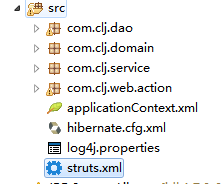
3、配置dao层
定义一个接口和其实现类
public interface CustomerDao { public void save(Customer customer); }
public class CustomerDaoImpl implements CustomerDao { public void save(Customer customer) { } }
4、定义业务层接口和实现类
package com.clj.service; import com.clj.domain.Customer; public interface CustomerService { public void save(Customer customer); }
package com.clj.service; import org.springframework.transaction.annotation.Transactional; import com.clj.dao.CustomerDao; import com.clj.domain.Customer; /** * 客户的业务层 * @author Administrator * */ public class CustomerServiceImpl implements CustomerService{//用来保存客户 public void save(Customer customer) { } }
5、定义pojo类
hibernate通过操作pojo类来操作数据库表,做到对象关系映射
package com.clj.domain; public class Customer { private Long cust_id; private String cust_name; private Long cust_user_id; private Long cust_create_id; private String cust_source; private String cust_industry; private String cust_level; private String cust_linkman; private String cust_phone; private String cust_mobile; public Long getCust_id() { return cust_id; } public void setCust_id(Long cust_id) { this.cust_id = cust_id; } public String getCust_name() { return cust_name; } public void setCust_name(String cust_name) { this.cust_name = cust_name; } public Long getCust_user_id() { return cust_user_id; } public void setCust_user_id(Long cust_user_id) { this.cust_user_id = cust_user_id; } public Long getCust_create_id() { return cust_create_id; } public void setCust_create_id(Long cust_create_id) { this.cust_create_id = cust_create_id; } public String getCust_source() { return cust_source; } public void setCust_source(String cust_source) { this.cust_source = cust_source; } public String getCust_industry() { return cust_industry; } public void setCust_industry(String cust_industry) { this.cust_industry = cust_industry; } public String getCust_level() { return cust_level; } public void setCust_level(String cust_level) { this.cust_level = cust_level; } public String getCust_linkman() { return cust_linkman; } public void setCust_linkman(String cust_linkman) { this.cust_linkman = cust_linkman; } public String getCust_phone() { return cust_phone; } public void setCust_phone(String cust_phone) { this.cust_phone = cust_phone; } public String getCust_mobile() { return cust_mobile; } public void setCust_mobile(String cust_mobile) { this.cust_mobile = cust_mobile; } @Override public String toString() { return "Customer [cust_id=" + cust_id + ", cust_name=" + cust_name + ", cust_user_id=" + cust_user_id + ", cust_create_id=" + cust_create_id + ", cust_source=" + cust_source + ", cust_industry=" + cust_industry + ", cust_level=" + cust_level + ", cust_linkman=" + cust_linkman + ", cust_phone=" + cust_phone + ", cust_mobile=" + cust_mobile + "]"; } }
6、定义Customer.hbm.xml
此配置文件关乎Customer这个pojo类,此文件需放在Customer pojo类同个包下
<?xml version="1.0" encoding="UTF-8"?> <!DOCTYPE hibernate-mapping PUBLIC "-//Hibernate/Hibernate Mapping DTD 3.0//EN" "http://www.hibernate.org/dtd/hibernate-mapping-3.0.dtd"> <hibernate-mapping> <class name="com.clj.domain.Customer" table="cst_customer"> <id name="cust_id" column="cust_id"> <generator class="native"/> </id> <property name="cust_name" column="cust_name"/> <property name="cust_user_id" column="cust_user_id"/> <property name="cust_create_id" column="cust_create_id"/> <property name="cust_source" column="cust_source"/> <property name="cust_industry" column="cust_industry"/> <property name="cust_level" column="cust_level"/> <property name="cust_linkman" column="cust_linkman"/> <property name="cust_phone" column="cust_phone"/> <property name="cust_mobile" column="cust_mobile"/> </class> </hibernate-mapping>
项目构建大致图
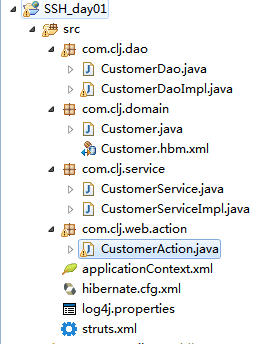
四、demo之保存客户初步演示
这里先初略的定义持久层交给heibernate,业务层交个struts2,创建实例交给spring
1、定义一个保存客户的界面,利用form表单进行数据的提交
根据域名可知,这里利用的是struts2的通配符方式进行访问
<FORM id=form1 name=form1 action="${pageContext.request.contextPath }/customer_add.action" method=post> <!--table部分省略--> </FORM>
2、在struts.xml中配置接受请求,根据action名和方法跳转指定的action,执行指定的方法
spring整合struts2方式一:action由struts2框架管理
* 因为导入的struts2-spring-plugin-2.3.24.jar 包自带一个配置文件 struts-plugin.xml ,该配置文件中有如下代码
* <constant name="struts.objectFactory" value="spring" /> 开启一个常量,如果该常量开启,那么下面的常量就可以使用
* struts.objectFactory.spring.autoWire = name,该常量是可以让Action的类来自动装配Bean对象!
<?xml version="1.0" encoding="UTF-8" ?> <!DOCTYPE struts PUBLIC "-//Apache Software Foundation//DTD Struts Configuration 2.1//EN" "http://struts.apache.org/dtds/struts-2.3.dtd"> <struts> <!-- 配置包结构 --> <package name="crm" extends="struts-default" namespace="/"> <!-- 配置客户的Action --> <!-- 方式一:aciton由struts2框架管理-->
<action name="customer_*" class="com.clj.web.action.CustomerAction" method="{1}"/>
</package>
</struts>
3、在spring的applicationContext.xml中配置相对应的bean以及事务
这里利用spring中IOC(控制反转)的特性,将创建实例的任务交给spring框架管理
<bean id="customerService" class="com.clj.service.CustomerServiceImpl"> <property name="customerDao" ref="customerDao"></property> </bean> <bean id="customerDao" class="com.clj.dao.CustomerDaoImpl"> <property name="hibernateTemplate" ref="hibernateTemplate"/> </bean> <bean id="hibernateTemplate" class="org.springframework.orm.hibernate5.HibernateTemplate"> <!-- 注入sessionFactory --> <property name="sessionFactory"/> </bean> </beans>
4、编写持久层实现类相关代码
这里利用hibernate提供的模板类,内部封转了session,从而可以调用session中的方法
/** * 持久层 * * @author Administrator * */ public class CustomerDaoImpl implements CustomerDao { //将数据保存到数据库中(调用模板类(hibernate提供,内部封装了session)) private HibernateTemplate hibernateTemplate; public void setHibernateTemplate(HibernateTemplate hibernateTemplate) { this.hibernateTemplate = hibernateTemplate; } /** * 保存客户 */ public void save(Customer customer) { System.out.println("持久层:保存客户"); hibernateTemplate().save(customer); } }
5、编写业务层实现类相关代码
package com.clj.service; import org.springframework.transaction.annotation.Transactional; import com.clj.dao.CustomerDao; import com.clj.domain.Customer; /** * 客户的业务层 * @author Administrator * */ @Transactional public class CustomerServiceImpl implements CustomerService{ private CustomerDao customerDao; public void setCustomerDao(CustomerDao customerDao) { this.customerDao = customerDao; } //用来保存客户 public void save(Customer customer) { System.out.println("业务层,保存客户"); customerDao.save(customer); } }
6、编写action相关代码
这里通过struts2的模板类
package com.clj.web.action; import org.apache.struts2.ServletActionContext; import org.springframework.web.context.WebApplicationContext; import org.springframework.web.context.support.WebApplicationContextUtils; import com.clj.domain.Customer; import com.clj.service.CustomerService; import com.opensymphony.xwork2.ActionSupport; import com.opensymphony.xwork2.ModelDriven; /** * 客户的控制层 * @author Administrator * */ public class CustomerAction extends ActionSupport implements ModelDriven<Customer>{ //不要忘记手动new private Customer customer=new Customer(); public Customer getModel() { return customer; } //提供service成员属性,提供set方法 private CustomerService customerService; public void setCustomerService(CustomerService customerService) { this.customerService = customerService; } /** * 保存客户 * @return */ public String add(){ System.out.println("WEB层,保存客户"); //方式一:创建web的工厂(action由struts2创建) WebApplicationContext context=WebApplicationContextUtils.getWebApplicationContext(ServletActionContext.getServletContext()); CustomerService cs=(CustomerService) context.getBean("customerService"); //调用方法 cs.save(customer);return NONE; } }
五、项目优化之整合
1、 spring整合struts2方式二:action由spring框架管理
把具体的Action类配置文件applicatonContext.xml的配置文件中,但是注意:struts.xml需要做修改
<struts>
<!-- 配置包结构 -->
<package name="crm" extends="struts-default" namespace="/">
<!-- 配置客户的Action -->
<!-- 方式一:aciton由struts2框架管理
<action name="customer_*" class="com.clj.web.action.CustomerAction" method="{1}"/>-->
<!-- 方式二:action由spring管理,class标签上只需要编写srping配置bean的ID值既可以-->
<action name="customer_*" class="customerAction" method="{1}"></action>
</package>
</struts>
2、在applicationContext.xml中配置Action类
注意:1)Spring框架默认生成CustomerAction是单例的,而Struts2框架是多例的。所以需要配置 scope="prototype"
2)此时没有struts2的自动装配,在action需要手动配置customerService属性,并在action类中生成set方法
<!-- 配置客户模块 -->
<!-- 强调:配置的Aciton,必须是多列的 -->
<bean id="customerAction" class="com.clj.web.action.CustomerAction" scope="prototype">
<!--注意:struts管理action时,基于其中有个struts-plugin的jar包,其中更改了一个
常量struts.objectFactory.spring.autoWire = name将其打开了,可以自动装配,只需要提供set方法
但是此时action由spring管理,自动装配失效,所以需要手动进行配置注入
-->
<property name="customerService" ref="customerService"></property>
</bean>
3、.配置事务
spring整合hibernate方式一:(带有hibernate.cfg.xml的配置文件。强调:不能加绑定当前线程的配置)
以前玩hibernate时,hibernate.cfg.xml都是由hibernate框架管理,其配置文件能生成sessionFactory,持久层加载此配置文件获取sessionFactory,从而创建工厂生成session,进行数据的增删改成,此时其配置文件应该交给spring管理,充分利用spring的IOC特性
Spring框架提供了一个HibernateDaoSupport的工具类,以后DAO都可以继承该类!!在引入hibernate核心配置文件之前,得让dao层继承一个父类HibernateDaoSupport,此父类内部封装了事务模板
看源码:

1)修改相对应的持久层实现类,让他继承HibernateDaoSupport
package com.clj.dao; import org.springframework.orm.hibernate5.HibernateTemplate; import org.springframework.orm.hibernate5.support.HibernateDaoSupport; import com.clj.domain.Customer; /** * 持久层 * 继承HibernateDaoSupport,内部封装了HibernateTemplate * @author Administrator * */ public class CustomerDaoImpl extends HibernateDaoSupport implements CustomerDao { //将数据保存到数据库中(调用模板类(hibernate提供,内部封装了session)) /*private HibernateTemplate hibernateTemplate; public void setHibernateTemplate(HibernateTemplate hibernateTemplate) { this.hibernateTemplate = hibernateTemplate; }*/ /** * 保存客户 */ public void save(Customer customer) { System.out.println("持久层:保存客户"); this.getHibernateTemplate().save(customer); } }
2)修改业务层让,开启事务注解
package com.clj.service; import org.springframework.transaction.annotation.Transactional; import com.clj.dao.CustomerDao; import com.clj.domain.Customer; /** * 客户的业务层 * @author Administrator * */ @Transactional public class CustomerServiceImpl implements CustomerService{ private CustomerDao customerDao; public void setCustomerDao(CustomerDao customerDao) { this.customerDao = customerDao; } //用来保存客户 public void save(Customer customer) { System.out.println("业务层,保存客户"); customerDao.save(customer); } }
3)修改applicationContext.xml文件
先引入hibernate配置文件
<!-- 编写bean,名称都是固定的,由spring提供,用来加载hibernate.cfg.xml的配置文件-->
<bean id="sessionFactory" class="org.springframework.orm.hibernate5.LocalSessionFactoryBean">
<!-- 配置路径:当启动服务器时 ,该对象就会被创建,从而加载hibernate.cfg.xml文件,从而生成sessionFactory对象-->
<property name="configLocation" value="classpath:hibernate.cfg.xml"/>
</bean>
配置平台事务管理:用来管理事务,注意现在使用的是Hibernate框架,所以需要使用Hibernate框架的事务管理器
<!-- 先配置平台事务管理器 -->
<bean id="transactionManager" class="org.springframework.orm.hibernate5.HibernateTransactionManager">
<!-- 注入事务,session能够管理事务,工厂能够创建session -->
<property name="sessionFactory" ref="sessionFactory"/>
</bean>
开启事务注解
<!-- 开启事务的注解 -->
<tx:annotation-driven transaction-manager="transactionManager"/>
去除模板类配置,并为持久层配置sessionFactory
<!-- 以后,Dao都需要继承HibernateDaoSupport,注入sessionFactory -->
<bean id="customerDao" class="com.clj.dao.CustomerDaoImpl">
<!--<property name="hibernateTemplate" ref="hibernateTemplate"/>-->
<!-- 这里不注入模板类,而是注入sessionFactory,因为模板需要session(封装了session)-->
<property name="sessionFactory" ref="sessionFactory"/>
</bean>
全部代码如下
<?xml version="1.0" encoding="UTF-8"?> <beans xmlns="http://www.springframework.org/schema/beans" xmlns:xsi="http://www.w3.org/2001/XMLSchema-instance" xmlns:context="http://www.springframework.org/schema/context" xmlns:aop="http://www.springframework.org/schema/aop" xmlns:tx="http://www.springframework.org/schema/tx" xsi:schemaLocation="http://www.springframework.org/schema/beans http://www.springframework.org/schema/beans/spring-beans.xsd http://www.springframework.org/schema/context http://www.springframework.org/schema/context/spring-context.xsd http://www.springframework.org/schema/aop http://www.springframework.org/schema/aop/spring-aop.xsd http://www.springframework.org/schema/tx http://www.springframework.org/schema/tx/spring-tx.xsd"> <!-- 编写bean,名称都是固定的,有spring提供,用来加载hibernate.cfg.xml的配置文件--> <bean id="sessionFactory" class="org.springframework.orm.hibernate5.LocalSessionFactoryBean"> <!-- 配置路径:当启动服务器时 ,该对象就会被创建,从而加载hibernate.cfg.xml文件,从而生成sessionFactory对象--> <property name="configLocation" value="classpath:hibernate.cfg.xml"/> </bean> <!-- 先配置平台事务管理器 --> <bean id="transactionManager" class="org.springframework.orm.hibernate5.HibernateTransactionManager"> <!-- 注入事务,session能够管理事务,工厂能够创建session --> <property name="sessionFactory" ref="sessionFactory"/> </bean> <!-- 开启事务的注解 --> <tx:annotation-driven transaction-manager="transactionManager"/> <!-- 配置客户模块 --> <!-- 强调:配置的Aciton,必须是多列的 --> <bean id="customerAction" class="com.clj.web.action.CustomerAction" scope="prototype"> <!--注意:struts管理action时,基于其中有个struts-plugin的jar包,其中更改了一个 常量struts.objectFactory.spring.autoWire = name将其打开了,可以自动装配,只需要提供set方法 但是此时action由spring管理,自动装配失效,所以需要手动进行配置注入 --> <property name="customerService" ref="customerService"></property> </bean> <bean id="customerService" class="com.clj.service.CustomerServiceImpl"> <property name="customerDao" ref="customerDao"></property> </bean> <bean id="customerDao" class="com.clj.dao.CustomerDaoImpl"> <!--<property name="hibernateTemplate" ref="hibernateTemplate"/>--> <!-- 这里不注入模板类,而是注入sessionFactory,因为模板需要session(封装了session)--> <property name="sessionFactory" ref="sessionFactory"/> </bean> <!-- 配置模板类(hibernate框架提供的,内部封装了session),此时交给spring管理,如果持久层继承了HibernateDaoSupport,则无需配置--> <!-- <bean id="hibernateTemplate" class="org.springframework.orm.hibernate5.HibernateTemplate"> 注入sessionFactory <property name="sessionFactory"/> </bean>--> </beans>
4)修改action类
因为注入了业务层实现类,所以此时可以直接调用业务层方法,无须加载bean
package com.clj.web.action; import org.apache.struts2.ServletActionContext; import org.springframework.web.context.WebApplicationContext; import org.springframework.web.context.support.WebApplicationContextUtils; import com.clj.domain.Customer; import com.clj.service.CustomerService; import com.opensymphony.xwork2.ActionSupport; import com.opensymphony.xwork2.ModelDriven; /** * 客户的控制层 * @author Administrator * */ public class CustomerAction extends ActionSupport implements ModelDriven<Customer>{ //不要忘记手动new private Customer customer=new Customer(); public Customer getModel() { return customer; } //提供service成员属性,提供set方法 private CustomerService customerService; public void setCustomerService(CustomerService customerService) { this.customerService = customerService; } /** * 保存客户 * @return */ public String add(){ System.out.println("WEB层,保存客户"); //方式一:创建web的工厂(action由struts2创建) /*WebApplicationContext context=WebApplicationContextUtils.getWebApplicationContext(ServletActionContext.getServletContext()); CustomerService cs=(CustomerService) context.getBean("customerService"); //调用方法 cs.save(customer);*/ customerService.save(customer); return NONE; } }
spring整合hibernate方式二:(不带有hibernate.cfg.xml的配置文件)
这里准备删除hibernate的核心配置文件,在删除之前,需要将其配置文件中的相关内容配置到spring的applicatioinContext.xml文件中取
1、查看hibernate.cfg.xml文件中的相关内容
* 数据库连接基本参数(4大参数)
* Hibernate相关的属性
* 连接池
* 映射文件
2、引入配置
引入连接池
<!-- 先配置C3p0的连接池 -->
<bean id="dataSource" class="com.mchange.v2.c3p0.ComboPooledDataSource">
<property name="driverClass" value="com.mysql.jdbc.Driver"/>
<property name="jdbcUrl" value="jdbc:mysql://192.168.174.130:3306/SSH"/>
<property name="user" value="root"/>
<property name="password" value="root"/>
</bean>
修改对应的sessionFactory:因为已经没有了hibernate.cfg.xml的配置文件,所以需要修改该配置,注入连接池
引入对象映射文件:因为已经没有了hibernate.cfg.xml的配置文件,不会扫描到该配置文件,需要注入
<!-- 编写bean,名称都是固定的,有spring提供,用来加载hibernate.cfg.xml的配置文件-->
<bean id="sessionFactory" class="org.springframework.orm.hibernate5.LocalSessionFactoryBean">
<!--先加载连接池 -->
<property name="dataSource" ref="dataSource"/>
<!-- 加载方言,加载可选项 -->
<property name="hibernateProperties">
<props>
<prop key="hibernate.dialect">org.hibernate.dialect.MySQLDialect</prop>
<prop key="hibernate.show_sql">true</prop>
<prop key="hibernate.format_sql">true</prop>
<prop key="hibernate.hbm2ddl.auto">update</prop>
</props>
</property>
<!-- 引入映射的配置文件 -->
<property name="mappingResources">
<list>
<value>com/clj/domain/Customer.hbm.xml</value>
</list>
</property>
</bean>
现在:applicationContext.xml全部代码如下
<?xml version="1.0" encoding="UTF-8"?> <beans xmlns="http://www.springframework.org/schema/beans" xmlns:xsi="http://www.w3.org/2001/XMLSchema-instance" xmlns:context="http://www.springframework.org/schema/context" xmlns:aop="http://www.springframework.org/schema/aop" xmlns:tx="http://www.springframework.org/schema/tx" xsi:schemaLocation="http://www.springframework.org/schema/beans http://www.springframework.org/schema/beans/spring-beans.xsd http://www.springframework.org/schema/context http://www.springframework.org/schema/context/spring-context.xsd http://www.springframework.org/schema/aop http://www.springframework.org/schema/aop/spring-aop.xsd http://www.springframework.org/schema/tx http://www.springframework.org/schema/tx/spring-tx.xsd"> <!-- 先配置C3p0的连接池 --> <bean id="dataSource" class="com.mchange.v2.c3p0.ComboPooledDataSource"> <property name="driverClass" value="com.mysql.jdbc.Driver"/> <property name="jdbcUrl" value="jdbc:mysql://192.168.174.130:3306/SSH"/> <property name="user" value="root"/> <property name="password" value="root"/> </bean> <!-- 编写bean,名称都是固定的,有spring提供,用来加载hibernate.cfg.xml的配置文件--> <bean id="sessionFactory" class="org.springframework.orm.hibernate5.LocalSessionFactoryBean"> <!--先加载连接池 --> <property name="dataSource" ref="dataSource"/> <!-- 加载方言,加载可选项 --> <property name="hibernateProperties"> <props> <prop key="hibernate.dialect">org.hibernate.dialect.MySQLDialect</prop> <prop key="hibernate.show_sql">true</prop> <prop key="hibernate.format_sql">true</prop> <prop key="hibernate.hbm2ddl.auto">update</prop> </props> </property> <!-- 引入映射的配置文件 --> <property name="mappingResources"> <list> <value>com/clj/domain/Customer.hbm.xml</value> </list> </property> </bean> <!-- 先配置平台事务管理器 --> <bean id="transactionManager" class="org.springframework.orm.hibernate5.HibernateTransactionManager"> <!-- 注入事务,session能够管理事务,工厂能够创建session --> <property name="sessionFactory" ref="sessionFactory"/> </bean> <!-- 开启事务的注解 --> <tx:annotation-driven transaction-manager="transactionManager"/> <!-- 配置客户模块 --> <!-- 强调:配置的Aciton,必须是多列的 --> <bean id="customerAction" class="com.clj.web.action.CustomerAction" scope="prototype"> <!--注意:struts管理action时,基于其中有个struts-plugin的jar包,其中更改了一个 常量struts.objectFactory.spring.autoWire = name将其打开了,可以自动装配,只需要提供set方法 但是此时action由spring管理,自动装配失效,所以需要手动进行配置注入 --> <property name="customerService" ref="customerService"></property> </bean> <bean id="customerService" class="com.clj.service.CustomerServiceImpl"> <property name="customerDao" ref="customerDao"></property> </bean> <!-- 以后,Dao都需要继承HibernateDaoSupport,注入sessionFactory --> <bean id="customerDao" class="com.clj.dao.CustomerDaoImpl"> <!--<property name="hibernateTemplate" ref="hibernateTemplate"/>--> <!-- 这里不注入模板类,而是注入sessionFactory,因为模板需要session(封装了session)--> <property name="sessionFactory" ref="sessionFactory"/> </bean> <!-- 配置模板类(hibernate框架提供的,内部封装了session),此时交给spring管理,如果持久层继承了HibernateDaoSupport,则无需配置--> <!-- <bean id="hibernateTemplate" class="org.springframework.orm.hibernate5.HibernateTemplate"> 注入sessionFactory <property name="sessionFactory"/> </bean>--> </beans>
此时可以安心的删除hibernate.cfg.xml文件了
这样SSH整合完毕
六、Hibernate模板常用方法
注意:以下代码省略了接口中的演示(偷了个懒,相信初学者不会看不懂)
1)插入:
持久层
package com.clj.dao; import java.util.List; import org.hibernate.criterion.DetachedCriteria; import org.springframework.orm.hibernate5.HibernateTemplate; import org.springframework.orm.hibernate5.support.HibernateDaoSupport; import com.clj.domain.Customer; /** * 持久层 * 继承HibernateDaoSupport,内部封装了HibernateTemplate * @author Administrator * */ public class CustomerDaoImpl extends HibernateDaoSupport implements CustomerDao { @Override public void update(Customer customer) { // TODO Auto-generated method stub this.getHibernateTemplate().update(customer); } }
业务层
package com.clj.service; import java.util.List; import org.springframework.transaction.annotation.Transactional; import com.clj.dao.CustomerDao; import com.clj.domain.Customer; /** * 客户的业务层 * @author Administrator * */ @Transactional public class CustomerServiceImpl implements CustomerService{ private CustomerDao customerDao; public void setCustomerDao(CustomerDao customerDao) { this.customerDao = customerDao; } @Override public void update(Customer customer) { // TODO Auto-generated method stub customerDao.update(customer); } }
测试类
package com.clj.test; import java.util.List; import javax.annotation.Resource; import org.junit.Test; import org.junit.runner.RunWith; import org.springframework.test.context.ContextConfiguration; import org.springframework.test.context.junit4.SpringJUnit4ClassRunner; import com.clj.domain.Customer; import com.clj.service.CustomerService; /** * 测试Hiberante模板类的简单方法 * @author Administrator * */ @RunWith(SpringJUnit4ClassRunner.class) @ContextConfiguration("classpath:applicationContext.xml") public class Demo1 { @Resource(name="customerService") private CustomerService customerService; /** * 测试插入 */ @Test public void run1(){ Customer customer=new Customer(); customer.setCust_id(1L); customer.setCust_name("测试"); customerService.update(customer); } }
2)以下为指定查询、查询所有、离线查询代码
持久层
package com.clj.dao; import java.util.List; import org.hibernate.criterion.DetachedCriteria; import org.springframework.orm.hibernate5.HibernateTemplate; import org.springframework.orm.hibernate5.support.HibernateDaoSupport; import com.clj.domain.Customer; /** * 持久层 * 继承HibernateDaoSupport,内部封装了HibernateTemplate * @author Administrator * */ public class CustomerDaoImpl extends HibernateDaoSupport implements CustomerDao { //将数据保存到数据库中(调用模板类(hibernate提供,内部封装了session)) /*private HibernateTemplate hibernateTemplate; public void setHibernateTemplate(HibernateTemplate hibernateTemplate) { this.hibernateTemplate = hibernateTemplate; }*/ /** * 保存客户 */ public void save(Customer customer) { System.out.println("持久层:保存客户"); this.getHibernateTemplate().save(customer); } @Override public void update(Customer customer) { // TODO Auto-generated method stub this.getHibernateTemplate().update(customer); } /** * 通过主键查询 */ public Customer getById(Long id) { return this.getHibernateTemplate().get(Customer.class, id); } /** * 查询所有 */ @Override public List<Customer> findAll() { String sql="from Customer"; List<Customer> list=(List<Customer>) this.getHibernateTemplate().find(sql); return list; } /** * QBC离线查询 */ @Override public List<Customer> findAllByQBC() { DetachedCriteria criteria=DetachedCriteria.forClass(Customer.class); List<Customer> list=(List<Customer>) this.getHibernateTemplate().findByCriteria(criteria); return list; } }
业务层
package com.clj.service; import java.util.List; import org.springframework.transaction.annotation.Transactional; import com.clj.dao.CustomerDao; import com.clj.domain.Customer; /** * 客户的业务层 * @author Administrator * */ @Transactional public class CustomerServiceImpl implements CustomerService{ private CustomerDao customerDao; public void setCustomerDao(CustomerDao customerDao) { this.customerDao = customerDao; } //用来保存客户 public void save(Customer customer) { System.out.println("业务层,保存客户"); customerDao.save(customer); } @Override public void update(Customer customer) { // TODO Auto-generated method stub customerDao.update(customer); } @Override public Customer getById(Long id) { // TODO Auto-generated method stub return customerDao.getById(id); } @Override public List<Customer> findAll() { return customerDao.findAll(); } @Override public List<Customer> findAllByQBC() { // TODO Auto-generated method stub return customerDao.findAllByQBC(); } }
测试类
package com.clj.test; import java.util.List; import javax.annotation.Resource; import org.junit.Test; import org.junit.runner.RunWith; import org.springframework.test.context.ContextConfiguration; import org.springframework.test.context.junit4.SpringJUnit4ClassRunner; import com.clj.domain.Customer; import com.clj.service.CustomerService; /** * 测试Hiberante模板类的简单方法 * @author Administrator * */ @RunWith(SpringJUnit4ClassRunner.class) @ContextConfiguration("classpath:applicationContext.xml") public class Demo1 { @Resource(name="customerService") private CustomerService customerService; /** * 测试插入 */ @Test public void run1(){ Customer customer=new Customer(); customer.setCust_id(1L); customer.setCust_name("测试"); customerService.update(customer); } /** * 测试查询指定的客户 */ @Test public void run2(){ Customer customer=customerService.getById(2L); System.out.println(customer); } /** * 查询所有的客户 */ @Test public void run3(){ List<Customer> list=customerService.findAll(); System.out.println(list); } /** * QBC(离线查询) */ @Test public void run4(){ List<Customer> list=customerService.findAllByQBC(); System.out.println(list); } }
七、关于SSH延迟加载问题
1. 使用延迟加载的时候,再WEB层查询对象的时候程序会抛出异常!
* 原因是延迟加载还没有发生SQL语句,在业务层session对象就已经销毁了,所以查询到的JavaBean对象已经变成了托管态对象!
* 注意:一定要先删除javassist-3.11.0.GA.jar包(jar包冲突了)
2. 解决办法
Spring框架提供了一个过滤器,让session对象在WEB层就创建,在WEB层销毁。只需要配置该过滤器即可
* 但是:要注意需要在struts2的核心过滤器之前进行,spring监听器之后配置
<!-- 解决延迟加载的问题 -->
<filter>
<filter-name>OpenSessionInViewFilter</filter-name>
<filter-class>org.springframework.orm.hibernate5.support.OpenSessionInViewFilter</filter-class>
</filter>
<filter-mapping>
<filter-name>OpenSessionInViewFilter</filter-name>
<url-pattern>/*</url-pattern>
</filter-mapping>
3、演示延迟加载
持久层:调用load方法,此方法时延迟加载的
/** * 延迟加载 */ @Override public Customer loadById(long id) { // TODO Auto-generated method stub return this.getHibernateTemplate().load(Customer.class, id); }
业务层
@Override public Customer loadById(long id) { // TODO Auto-generated method stub return customerDao.loadById(id); }
测试类
@Test public void run5(){ Customer customer=customerService.loadById(2L); System.out.println(customer); }